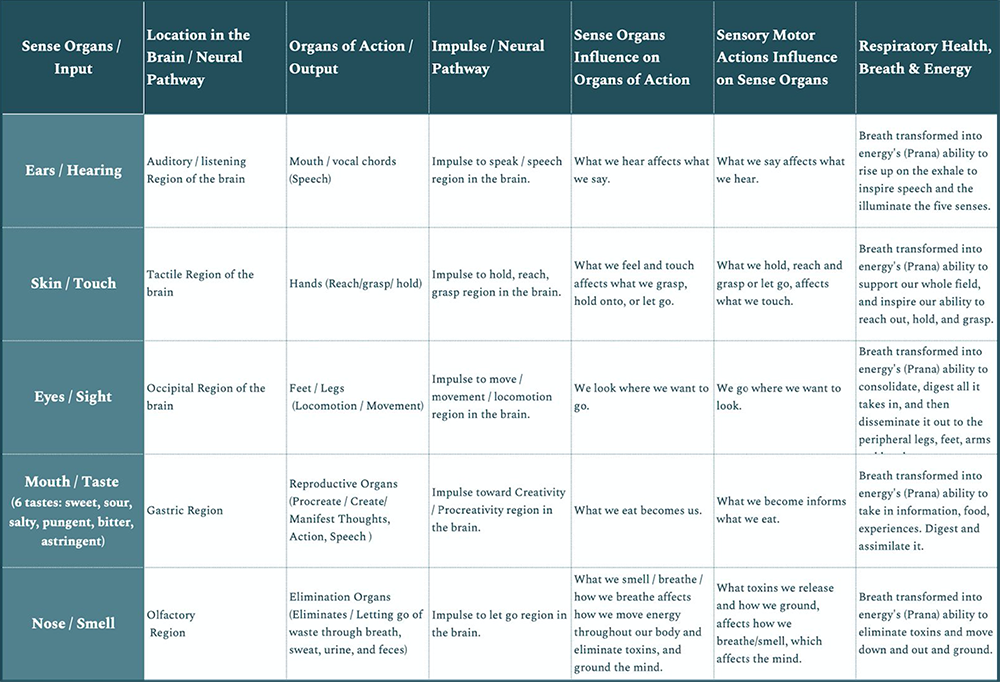What’s On Your Mind? Part 8:
Common Sense, The Breath & The Mind
Brighten the Mind, Nourish the Senses, Refine The Breath
We use common phrases to speak to the magnificence of our bodies, mind, and breath. Does it make sense? Use your common sense. What’s on your mind? Let me catch my breath. Yet we often do not pause long enough to consider our brilliance. The more we understand how it all works together in our daily life, the more we can begin to self-regulate, self-heal, self-sense, and self-realize our life’s work and contribution to the planet. With this in mind, (haha), a recap:
The Mind & The Senses
Human Beings are primed to make sense of the world. We learn through our 11 instruments—5 sense organs, 5 organs of action and the mind supported by essential breath that supports good energy (prana).
The mind has four parts that work together: the sensory mind brings in information to create memory, which in turn supports our discernment and informs our self-identity through the actions we take in the world.

The mind is a reflection of the whole body/vehicle. The brain is different from the mind, it is the dashboard telling the information where to go in the body, and the body how to act in the world.
The mind can have three primary colorings: It can be calm, focused and clear. It can be active/ transformative/ overactive. It can be dull and lethargic. Or a combination of these three.
The mind is informed by the sense organs and how clear and calm and focused they are, and where they direct their attention. The conditioning of our mind directs our senses, and this informs where we place our awareness. The mind takes in information with these sensory input organs–primarily the five senses and the breath, and when calm and clear puts skillful action back out into the world through the output organs of action and the breath.
Breath & Prana (Vital Life Force)
If we look at the sensory motor loop and the influence of breath/respiratory system and the energy (prana-breath transformed into our body’s vital life force energy), we gain a better understanding how these 11 instruments and the breath facilitate learning when supported and nourished, stimulated and used well. Instead of senses and breath that are under-stimulated/overstimulated or misused.
If the mind is clear, calm and focused the five primary senses used for taking in information/learning and the breath patterns, can be clear, calm and focused, ready to learn and be optimally directed. When the senses are calm and focused the mind is calm and focused.
When the breath is calm and regulated the mind is calm and regulated. This calm, focused regulated mind and brain and breath support a system ready to learn creating a cycle that brings thought (mixed with emotion) speech, and action into supporting a person being a clear, thoughtful, focused citizen of the world.
Optimal State for Learning
When these 11 instruments and the breath and energy (prana) are ready to pay attention and learn well, education can be done in optimal ways with greater ease. Otherwise when we are in a state of distracted, stupefied, dulled, blocked, or disturbed senses and breath it in turn affects our senses, mind, brain and breath patterns from learning well, and makes our responses/ work/ integration of the learning distracted, disturbed and creates sub optimal learning and educational conditions.
Sense Organs & Organs of Action aka Sensory-Motor Loop
The input sense organs, and output organs of action illustrate the sensory motor loop flow, and how learning happens. The brief bullet on breath illuminates how it affects our system as it pertains to this sensory motor loop. There is so much more on all of this, but try sensing and feeling the connections to these sensory motor loops within your system and see what happens when you give them the just right stimulus to then focus well. (A graph for visual learners is also below.)
- Sense of Sound: input sense organ – ears (listening) / output organ of skillful action in the world – mouth (speech). What we hear affects what we say and what we say affects what we hear.
- Sense of Touch: input sense organ – skin (feeling) / output organ of skillful action in the world – hands (grasping). Reaching, grasping, holding, letting go. What we feel and touch affects what we grasp, hold onto, or let go; what we hold, reach and grasp or let go affects what we touch and feel.
- Sense of Sight: input sense organ – eyes (sight) / output organ of skillful action in the world – feet (locomotion/movement). We look where we want to go; we go where we want to look.
- Sense of Taste: input sense organ – mouth (6 tastes sweet, sour, salty, pungent, astringent, bitter) / output organ of skillful action in the world – reproductive organs, our ability to create and manifest in the world our desires and thoughts. What we eat becomes us – and what we become informs what we eat and how we nourish ourselves mentally, emotionally, and physically.
- Sense of Smell: input sense organ – nose (smell)/ output organ of skillful action in the world – organs of elimination (remove toxins from the body which keeps the mind that is in the whole body clear – by eliminating the toxins through breath, sweat, urine, feces). What we smell/breathe/how we breathe, all affects how we move energy throughout our body, and eliminate toxins or waste that can build up. If not released it affects our body’s ability to stay clear and free of dis-ease, which affects the mind. What we release affects how we breathe/smell, etc. and how well we process our toxins out of our system daily, which also affects the mind.
- Breath: Having an essential, diaphragmatic, functional breath pattern affects our whole being wellness. The delicate balance of oxygen and carbon dioxide is needed for health, wellness, and robust, balanced immune systems. (e.g. Some ways that dysfunctional breath can show up is reverse breathing, secondary breath muscles acting as primary, restrained breath, not enough oxygen or carbon dioxide/its balance and ph etc can lead to many symptoms in the tissues/ body/ physical, mental and emotional health and wellness.
* To read more about the breath from a western medical and Yoga and Ayurveda perspective Restoring Prana by Robin Rothenberg is a great resource, or Breath by James Nestor for a journalistic take on Breath.)
If the senses are blocked or respiratory patterns are compensated, the mind, health and learning are negatively affected. So stay well, brighten the mind – polish it with your daily routines, nourish your senses with your life, and refine your breath to restore your vitality. It will serve you well today and in your life.
A chart of the above is below for your reference. Download chart

Elizabeth Sullivan
Elizabeth Sullivan is an expert instructor, certified yoga therapist, and practitioner in Yoga, Energy Work and Ayurveda. She supports the body to optimally function using neuromuscular reeducation and working with energy patterns. By integrating and aligning body, mind and spirit energy, she creates relaxation, increased energy flow, optimized sleep and a clear mind for her clients. Her work helps people hold higher consciousness to live their optimal lives. Elizabeth offers private lessons, group classes and workshops, and online programs for health practitioners, and also writes for health publications. She holds advanced degrees in Dev. Psychology, Education and Writing, along with certifications in each instructional area. To learn more, visit elizabetheilerssullivan.com.
 Elizabeth Sullivan, MFA, MA, BA, Certified Yoga Therapy, Energy Medicine
Elizabeth Sullivan, MFA, MA, BA, Certified Yoga Therapy, Energy Medicine
elizabetheilerssullivan.com
Founding member, Community for Higher Consciousness
See Elizabeth’s bio and class schedule.
Subscribe to our blog for more like this. View full classes and workshops calendar.
|
|